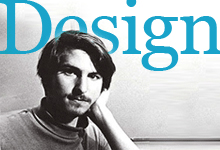Letters on a computer screen were two-dimensional blips and characters that rolled along as you typed them in before Steve Jobs and his team created the windows interface.
Jobs gave visual depth to things.
He put drop shadows between elements so that we could see which item was “on top” of our desktop, which was below.
It’s mind blowing. Elements as simple as drop shadows, sketched by Jobs in his garage when he was 20 years old, have become part of a worldwide visual lexicon that allows us to intuitively interact with information.
We don’t even think about the small details, because we expect to be able to push a button, move a mouse, pinch a screen and have the world come to us.
Jobs created that expectation, step-by-step and with a vision for making things intuitive, easy and fun to use.
Let’s talk about the mouse. Really? Why is it a “mouse”? Because it has a tail and it resembles the critter.
The original mouse design isn’t Jobs,’ but his integration with a visual interface has made it something else we take for granted, and something to which we have a certain emotional attachment. Apple made significant refinements to the design. Click on a mouse and it’s a comfortable, reliable, extension of our hand, easy to use.
Usability matters a great deal.
“Design is not just what it looks like and feels like. Design is how it works,” Jobs said.
Jobs allowed us to click on things that aren’t really there and put them in places that don’t physically exist.
Long before you “threw something away” on your computer, Jobs was sketching out what a digital trashcan might look like. It should look … like a trashcan! He imagined what it might feel like to “drag and drop” something into it.
Roll your “mouse” over an “icon”’ (a word that used to conjure up a religious relic of some sort) and it feels and sounds as if you have pressed a button.
How long do you have to wait before your page loads? Just check the progress bar. Useful, visual information at its finest.
Even the packaging and instruction design for Apple products are about usability. There’s something about opening the box and the conversational way the instructions are designed and written that makes you feel like someone is talking you through the experience.
These tiny details are the DNA of data visualization and what engages users.
Jobs loved detail. He once took a calligraphy class while at Reed College and came away from it with a deep appreciation of typographic detail: serif and sans serif; varying the amount of space between different letter combinations and about “what makes great typography great,” he said in a commencement address at Stanford University in 2005.
“If I had never dropped in on that single course in college,” he said, “the Mac would have never had multiple typefaces or proportionally spaced fonts.”
And his designs had an overwhelming impact on the design of other personal computers.
From the beginning at Apple, Jobs insisted on hiring the right people to hone his products: designers, developers, researchers and behavioral psychologists who could identify the needs, motivations and behaviors of users. Jobs wanted to create products that emphasized the user goals and experience first.
New career tracks in design and user interaction have been fueled and perhaps even invented by Jobs’ interests in optimizing the emotional engagement of his products.
Just think how much fun you’d have today on Facebook if you had to use a Linux-based system to post your status. None.
The first time I ever saw a Mac was at my brother Tim’s corporate office in Wichita in 1984. He said, “You’ve got to come over to see this.” When he touched the mouse, the screen lit up and we saw a friendly little computer screen with the word “Hello.”
“Make it do that again!!” I said.
And I was far from a computer novice at the time. I’d worked as a typesetter for a number of years. But to see a free form, organic shape on a computer screen and beautifully designed navigation made me really excited.
Have you had a similar experience with an Apple product? Don’t we all have that feeling now, when we see a usable, well-designed and intuitive new device of some sort?
Thanks, Mr. Jobs.







Comments